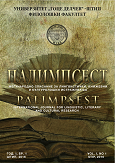CHRISTIANA DE CALDAS BRITO: BETWEEN SAUDADE AND REVERSE ART
DOI:
https://doi.org/10.46763/PALIM24918149eAbstract
The contribution aims to investigate saudade and reverse art in the Christiana de Caldas Brito’s literary production, a Brazilian writer living in Italy. Saudade, a concept dense of semantic layers, represents a cross-cutting thread, defining a ‘suspended’ existential condition between the memory of a lost past, the tension toward an imaginary future and a present steeped in incompleteness. In the writer's works, the characters embody a condition of perpetual oscillation, carrying with them a sense of lack that is not only deprivation, but also a space of potential transformation. Saudade manifests itself in their experiences as a constructive melancholy, paving the way for the discovery of a more authentic dimension of their existence. The mirror, a key element in the novel The Impatients, becomes a place of access to the unconscious and the ‘reverse’ of reality, an enigmatic territory where a process of identity recomposition takes place. The theme of mending serves as a paradigm for the recovery and reworking of inner lacerations, in a path that recalls the practice of tailoring as a metaphor of the psychological repair. Ecìla discovers herself only after crossing the mirror, a symbol of the boundary between conscious and unconscious, to access the ‘reverse’ of reality, a dimension where the sense of self is revealed in its complexity and depth. Writing, a Bergsonian space of duration, becomes the way of giving voice to a polysemic emotional experience, in which the past, present and future intertwine and blur, creating a plural and dynamic identity.
Keywords: border; crossing; identity; mirror; reverse; saudade.


